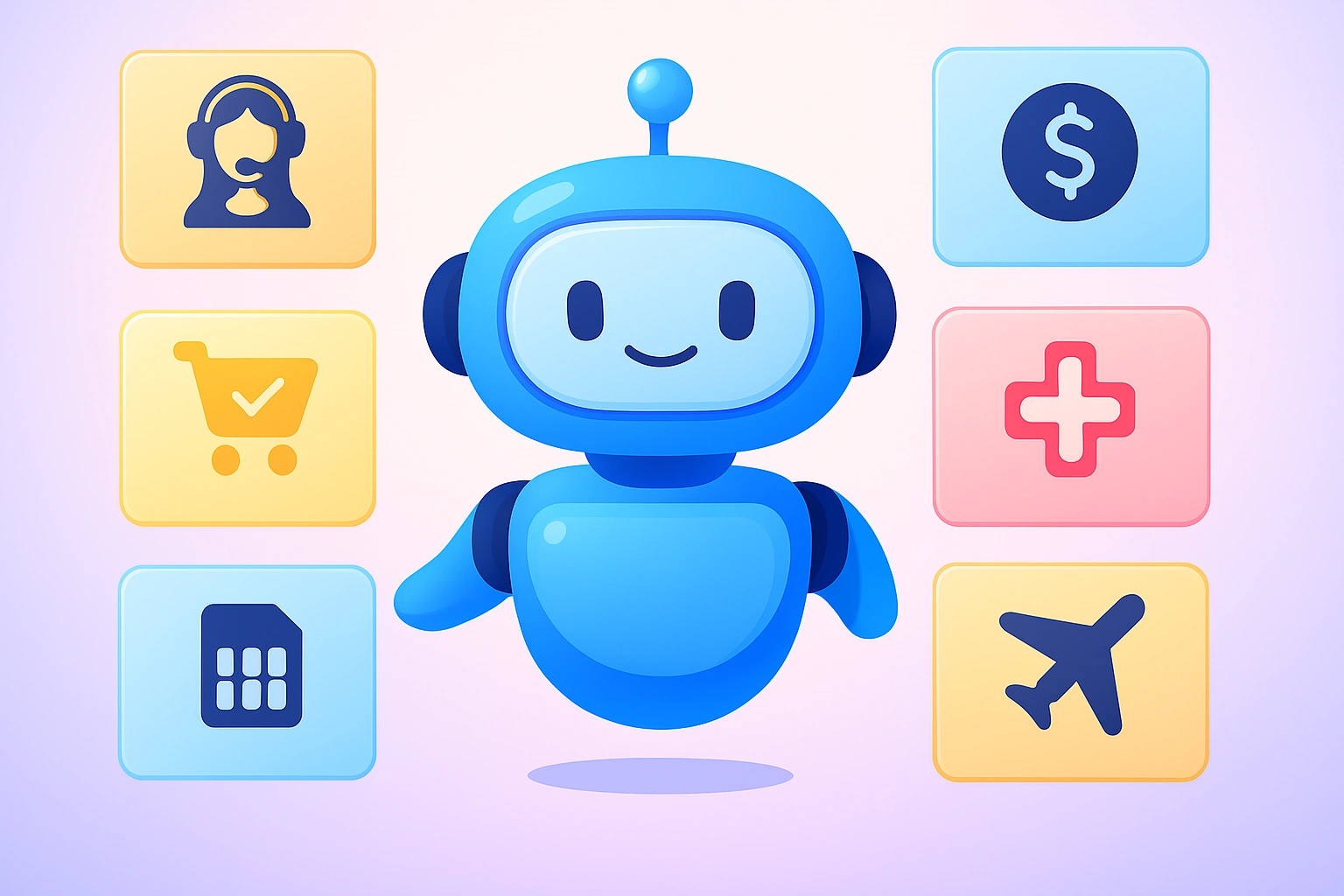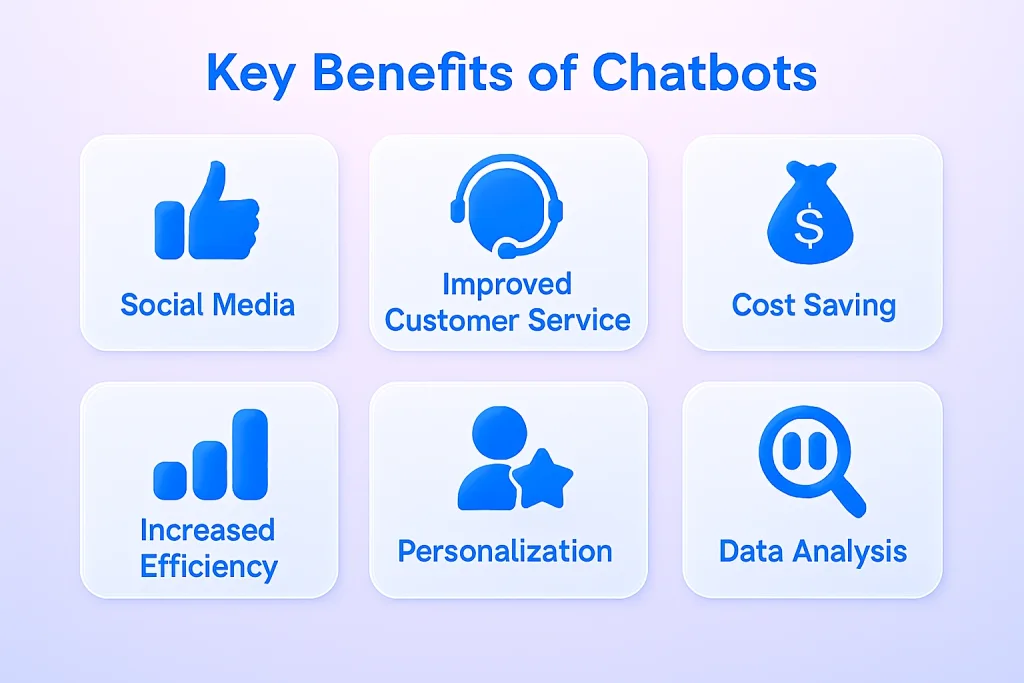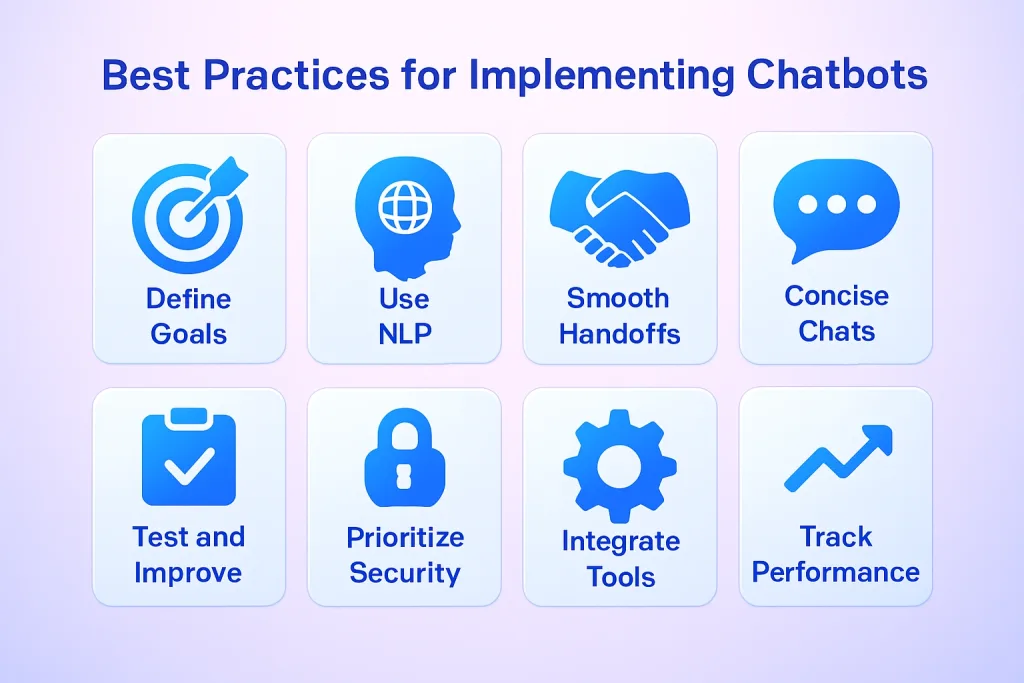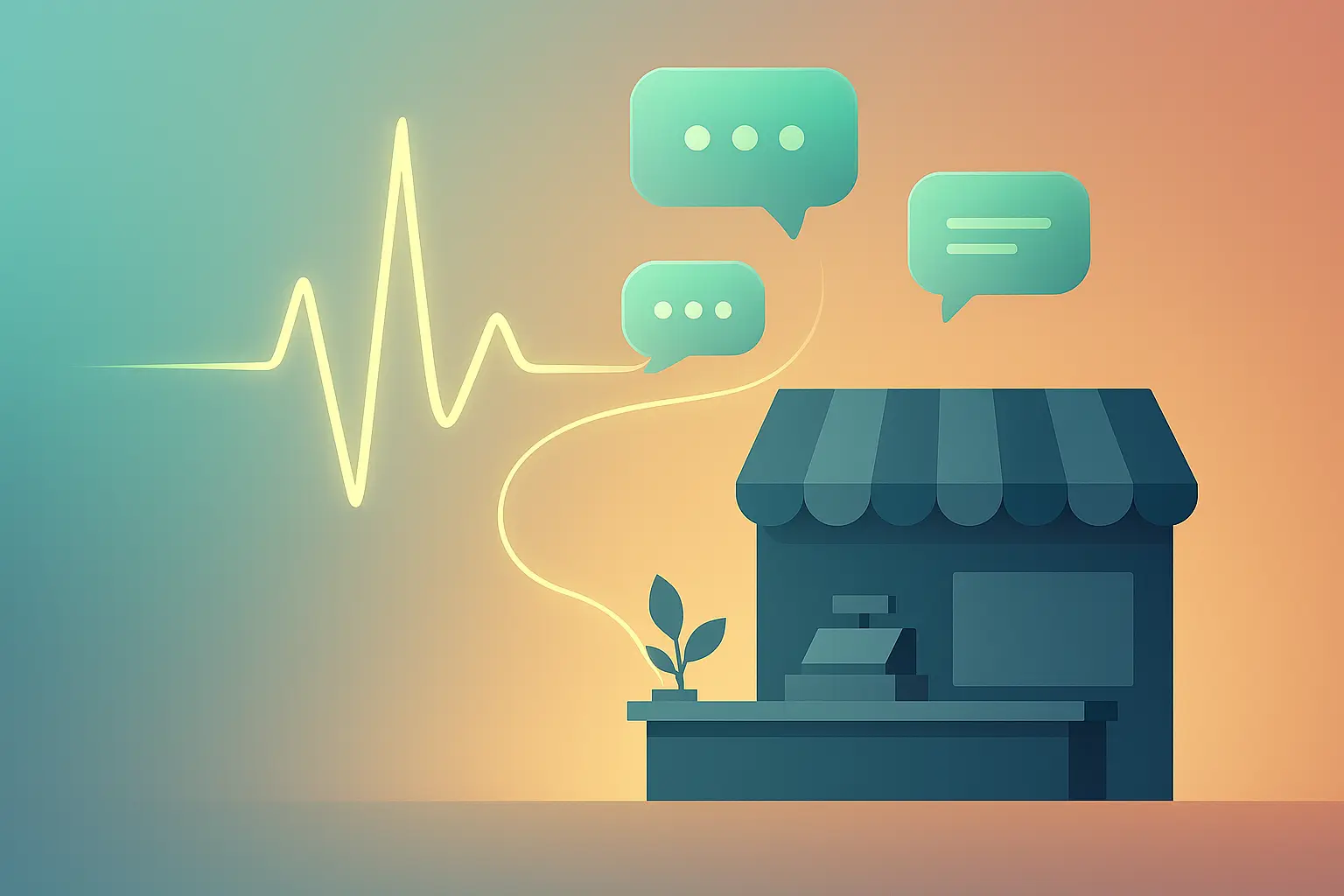15 Chatbot Use Cases for 2025: Boost Efficiency & Engagement
- July 31, 2025
- 8 mins read
- Listen

Losing leads to slow responses? Or maybe high support costs are eating into your profits? Chatbots are solving these business headaches with a $15.57 billion market proving their power. These AI-driven tools tackle customer churn, streamline operations, and boost sales like never before.
In this guide, we’ll explore the diverse use cases of chatbots across industries, benefits, and best practices to harness their full potential in driving business success.
What is a Chatbot?
A chatbot is an AI-powered tool that chats with users through text or voice, mimicking human conversation. It’s like having a tireless assistant who works 24/7 to answer queries, solve problems, or even close sales.
Using technologies like natural language processing (NLP) and machine learning (ML), chatbots understand user needs and respond with speed and accuracy.
Learn More: What is a Chatbot and How Does it Work
7 Key Benefits of Chatbots for Your Business

- 24/7 Availability: Chatbots never sleep. They answer customer queries anytime, cutting wait times and keeping your business open around the clock.
- Cost Savings: Hiring more staff to handle inquiries? Chatbots automate routine tasks, and you get efficient service without breaking the bank.
- Improved Customer Satisfaction: Long wait times frustrate customers. Chatbots deliver instant, accurate responses, with 67% of users preferring them for quick answers.
- Increased Efficiency: Repetitive tasks like scheduling or FAQs slow your team down. Chatbots handle these instantly, freeing staff to tackle complex issues.
- Personalization: Generic responses turn customers away. Chatbots use data to offer tailored recommendations, like suggesting products based on past purchases.
- Scalability: Peak seasons overwhelming your team? Chatbots handle thousands of chats at once, scaling effortlessly without extra hires.
- Data Insights: Want to know what customers really think? Chatbots collect feedback and preferences during chats, providing valuable insights.
- Lead Generation: Missed leads hurt growth. Chatbots qualify prospects and book meetings 24/7, boosting conversions by up to 4x compared to forms.
15 Most Prominent Use Cases of Chatbots
Chatbots are solving real business problems. Whether this is from slashing support costs to boosting sales, they’re a game-changer across industries.
Let’s explore a chatbot use case.
1. Customer Service
Swamped by endless customer questions? Chatbots handle FAQs instantly, slashing response times to seconds. They deliver consistent, accurate answers, keeping customers happy 24/7. Here is how you can
make customer support easy and efficient with an FAQ chatbot.
With 67% of users favoring quick replies, chatbots cut support costs dramatically. They free your team for tougher challenges, boosting efficiency.
No more frustrated clients or overwhelmed agents.
2. Sales and Lead Generation
Missed leads are killing your revenue? Chatbots work nonstop to qualify prospects and book meetings. They ask smart questions, engaging visitors conversationally to drive 4x higher conversions than forms.
Perfect for capturing interest on your website. They ensure no opportunity slips away. Your sales pipeline stays packed. Say goodbye to lost deals.
3. Marketing
Struggling to keep customers engaged during campaigns? Chatbots spark instant interactions, making users feel valued. They scale effortlessly during peak times, handling thousands of chats without extra staff.
With 80% of businesses using them for marketing, they personalize offers to boost click-throughs. Your campaigns get a major lift. No more missed connections.
4. Social Media Engagement
Customers expect lightning-fast replies on social platforms. Chatbots shine on Facebook or Twitter, answering queries in real time.
They strengthen your brand’s presence without draining resources. By handling complaints or questions instantly, they keep followers loyal.
Your social game stays strong. No more ignored messages piling up.
5. Messaging Apps
Shoppers want convenience on WhatsApp or WeChat. Chatbots drive sales through conversational commerce, with 47% of users ready to buy via bots.
They simplify transactions, from inquiries to confirmations, on mobile-first platforms. This meets customers where they are, boosting engagement.
Your sales soar effortlessly. Goodbye, clunky checkout processes.
6. Human Resources
HR is drowning in repetitive queries? Chatbots automate hiring tasks and employee support, saving hours daily. They answer questions about benefits or leave policies in seconds, freeing HR for strategic work.
From screening candidates to onboarding, they streamline processes. Your team stays focused on growth. No more bogged-down HR staff.
7. Personal Services (Fitness, Health)
Sticking to fitness goals feels impossible without support. Chatbots act as virtual coaches, delivering tailored diet or workout plans. They boost commitment, with users 26% more likely to succeed.
By tracking progress and sending reminders, they keep motivation high. Your clients stay on track. No more abandoned resolutions.
8. Voice-Based Chatbots
Busy users crave hands-free solutions. Voice bots deliver seamless support via devices like Alexa, perfect for banking or retail.
They handle queries with natural speech, cutting call center costs. Growing fast in 2025, they make interactions effortless. Your customers get quick answers, anywhere. Say farewell to long phone waits.
Learn more: Chatbot vs. Voicebot.
9. User Retention
Losing customers stings your bottom line. Chatbots boost loyalty with timely support and personalized offers, increasing lifetime value by 34%.
They predict needs, suggesting products at the right moment. This keeps users coming back, strengthening your brand. Your retention rates climb. No more churn eating profits.
10. Appointment Scheduling
Manual bookings frustrate everyone. Chatbots streamline scheduling by syncing with calendars for real-time availability.
They send automated reminders, cutting no-shows significantly. Users book effortlessly via chat, saving staff time. Your business runs smoother.
11. Order Tracking
Uncertain customers flood the support with order questions. Chatbots share real-time tracking updates, easing anxiety and reducing tickets.
They provide instant shipping details, boosting transparency. This keeps shoppers happy and loyal. Your support team breathes easier. No more repetitive “where’s my order?” calls.
12. Feedback Collection
Struggling to understand customer needs? Chatbots gather insights through conversational surveys, making feedback easy.
They spot trends in real time, helping you tweak products fast. Users share thoughts effortlessly, improving your offerings.
Your business stays customer-focused. Say hello to smarter decisions.
13. Language Translation
Language barriers block global growth. Chatbots translate text or voice instantly, connecting diverse audiences.
They support multilingual chats, expanding your market reach. Perfect for customer service or e-commerce, they foster inclusivity. Your business goes global. No more lost international customers.
14. Onboarding and Training
New hires or users need fast guidance. Chatbots deliver interactive training and policy info, speeding up learning.
They answer questions 24/7, reducing trainer workload. With engaging content like quizzes, they boost retention. Your onboarding process shines. Goodbye, lengthy training sessions.
15. Expense Tracking
Manual finance tracking wastes time. Chatbots automate expense logging, helping businesses or users budget smarter. They categorize spending and flag overspending instantly.
This brings clarity to financial health, saving hours. Your team makes better money decisions. No more spreadsheet headaches.
Best Practices for Implementing Chatbots in 2025

Want to make your chatbot more impactful for your business? Smart planning is key. These practical tips will help you deploy a chatbot that boosts efficiency and delights customers.
Let’s dive into the best practices for success.
1. Define Clear Goals
Start by setting specific objectives. Do you want to cut support costs or boost sales? For example, a retail chatbot could aim to reduce cart abandonment by 20%. Clear goals keep your chatbot focused and effective.
2. Use NLP and Machine Learning
A chatbot that misreads queries frustrates users. Natural language processing (NLP) and machine learning (ML) help it understand context and respond naturally.
Train it with diverse data to handle slang or typos. As a result, your chatbot gets smarter over time.
3. Enable Smooth Human Handoff
Some queries need a human touch. Ensure your chatbot hands off complex issues seamlessly. Integrate it with your CRM so agents see the full chat history. This keeps conversations smooth and builds trust.
4. Keep Chats Short and Friendly
Nobody likes robotic replies. Use concise, warm responses for simple queries like “Track my order.” For detailed questions, provide enough info without overwhelming users.
A friendly tone makes your chatbot feel like a helpful colleague.
5. Test and Improve Regularly
A chatbot isn’t a one-and-done tool. Test it with real-world scenarios, like vague or angry queries. Analyze logs to spot issues, such as frequent drop-offs. Regular tweaks keep your chatbot relevant and effective.
6. Prioritize Privacy and Security
Users need to trust your chatbot. Comply with regulations like GDPR or HIPAA, especially for sensitive data. Be clear about how you use chat data. Transparency encourages engagement and builds confidence.
7. Integrate with Your Tools
Connect your chatbot to your CRM, e-commerce platform, or analytics tools. This ensures smooth data flow and personalization. For instance, a sales chatbot can log leads directly, saving time and boosting efficiency.
8. Track Performance
Measure your chatbot’s success with analytics. Track response time, resolution rate, and user satisfaction. If 80% of queries resolve without help, you’re on the right track. Use feedback to refine performance and prove ROI.
Conclusion
Chatbots are no longer just a trend. They’re a must-have for businesses battling long wait times, high costs, and customer churn. It is from streamlining support to supercharging sales, these 15 use cases show how AI-driven tools transform industries like retail, healthcare, and HR.
As technology evolves, chatbots will only get smarter, with generative AI and voice capabilities paving the way for even better experiences.
Want to stay ahead? REVE Chat’s platform makes it easy to build chatbots that tackle your toughest challenges, delivering results fast.
Curious about how it works? Book a demo with our team or start a free trial today to see why businesses trust REVE Chat to drive growth and keep customers smiling!
Frequently Asked Questions
Chatbots excel at simple queries but can escalate complex issues to human agents seamlessly. With CRM integration, they ensure smooth transitions, keeping customers happy.
Chatbots use data like purchase history to offer tailored suggestions, boosting engagement.
Yes, chatbots can comply with GDPR or HIPAA, ensuring safe data handling. Encryption and transparency about data use build customer trust.
Retail, healthcare, and e-commerce see huge gains, with chatbots streamlining support and sales. They also shine in HR and finance, tackling queries and boosting efficiency.




